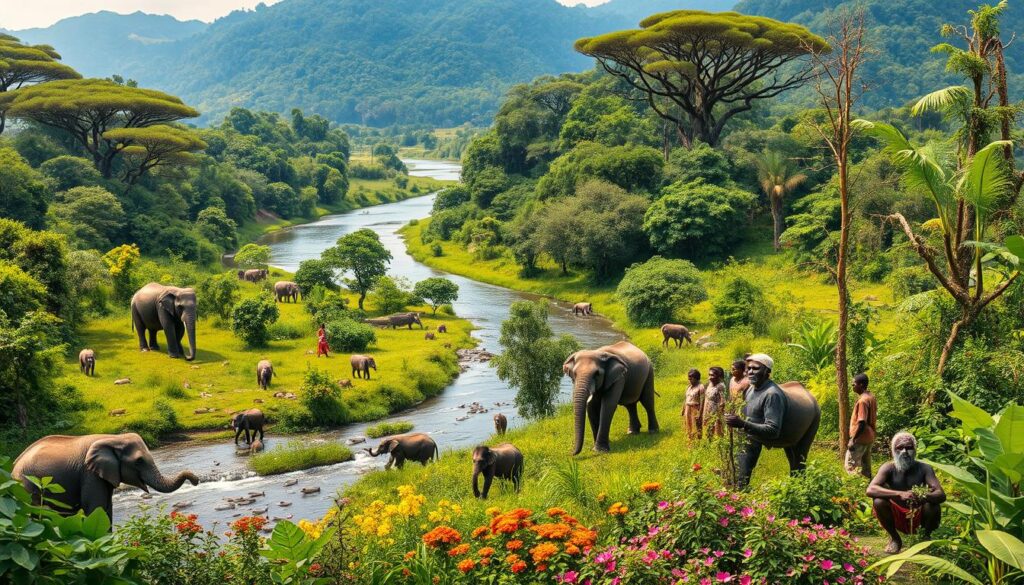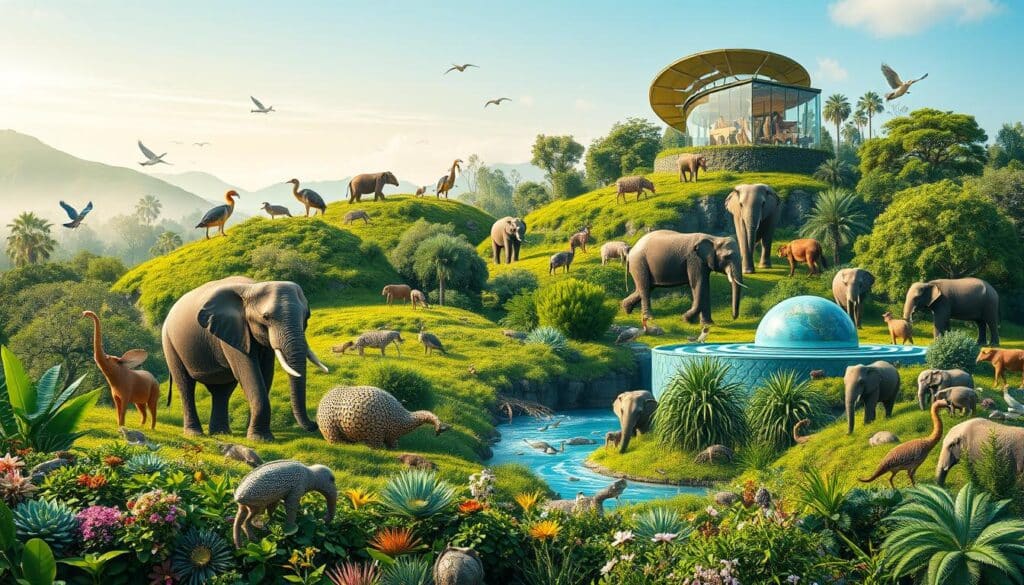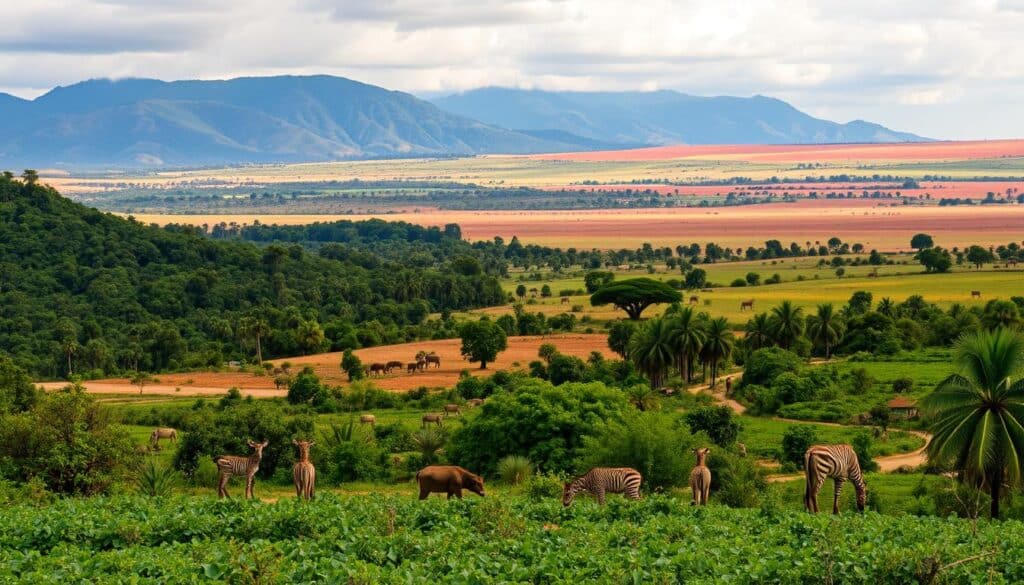Sustainable wildlife management is key to keeping nature and people in balance. The Convention on Biological Diversity says it’s about managing wildlife well. This means keeping their numbers and homes safe, while also helping people’s needs.
This approach covers many areas. It includes using wildlife for food, creating tools to track wildlife, and working together from different fields. It also looks at how people use wildlife for food and how it helps them eat well.
The Collaborative Partnership on Sustainable Wildlife Management is a group of 14 organizations. They work together to manage wildlife better. They want to stop wildlife numbers from dropping too low. This is because of things like losing their homes, being hunted, and more people wanting to eat wild meat.
Key Takeaways
- Sustainable wildlife management covers many things, like using wildlife for food and tracking it. It also involves working together and looking at how wildlife helps people eat.
- The Collaborative Partnership on Sustainable Wildlife Management is a group of 14 organizations. They work together to manage wildlife better.
- Sustainable wildlife management aims to stop wildlife numbers from dropping too low. This is because of things like losing their homes, being hunted, and more people wanting to eat wild meat.
- Sustainable wildlife management is crucial for preserving the delicate balance between nature and human populations, ensuring the conservation of wildlife species and the food and income security of local communities.
- The Sustainable Wildlife Management (SWM) Programme is a major international initiative funded by the European Union, the French Facility for Global Environment (FFEM), and the French Development Agency (AFD).
The Importance of Sustainable Wildlife Management
The world’s wildlife populations have seen a huge drop in recent years. Since 1970, the sizes of wild animal populations have seen an average drop of 68 percent. This decline is due to many factors, like habitat loss, over-exploitation, invasive species, pollution, and climate change.
Millions of people worldwide still rely on wildlife for food, culture, and jobs. Sustainable wildlife management tries to keep wildlife and habitats healthy. It also considers the needs of people.
Alarming Decline in Wildlife Populations
The numbers are shocking. 26% of mammals and 13% of birds in tropical humid forests are listed as endangered or vulnerable by the International Union for Conservation of Nature (IUCN). In East and Southeast Asia, tens of millions of wild animals are traded each year regionally and globally for food or use in traditional medicines. The Congo Basin alone sees over 4.5 million tonnes of wild animal meat extracted yearly. The Amazon Basin’s mammal meat trade is estimated to be over 1 million tonnes annually.
These declines highlight the urgent need for sustainable wildlife management. We must find ways to balance wildlife and human needs. By protecting habitats, regulating hunting and trade, and involving local communities, we can ensure a future where both wildlife and people can thrive.
“Sustainable wildlife management aims to sustain wildlife populations and habitats over time, while taking into account the socioeconomic needs of human populations.”
Sustainable Wildlife Management Programme

The Sustainable Wildlife Management (SWM) Programme is a big effort to protect wildlife in Africa, the Caribbean, and the Pacific. It’s funded by the European Union for seven years. The goal is to find new ways to save wild animals and protect their homes. At the same time, it aims to help people who live off these resources.
Key Goals and Objectives
The SWM Programme has several main goals:
- Achieve 100 percent inclusion of women and ethnic minorities in all programme activities at both field and national levels.
- Empower and ensure active participation of women, men, boys, and girls from local communities through mechanisms like Free, Prior, and Informed Consent (FPIC) and Grievance Redress Mechanism (GRM).
- Implement social safeguards (SoS) at each site, focusing on gender equality and women’s empowerment.
- Integrate gender considerations throughout the project cycle, including baseline gender-sensitive surveys, technical assistance on gender strategies, and integration of gender considerations into tools like Benefit Needs Surveys and letters of agreement.
The SWM Programme is run by a group of organizations. These include the Food and Agriculture Organization (FAO), Center for International Forestry Research (CIFOR), Wildlife Conservation Society (WCS), and CIRAD.
In Cameroon, the programme will help ten Baka and ten Bantu villages. These villages have about 6,000 people, with 5,000 living in rural areas. The goal is to help manage forest resources better, focusing on local livelihoods and Indigenous Peoples.
The SWM Programme in Cameroon will last until July 2026. It aims to reduce the use of wild meat that’s not sustainable. It wants to make sure there’s enough food in wildlife-rich areas. The European Union, French Facility for Global Environment, and French Development Agency are funding it.
The Role of FAO in Sustainable Wildlife Management

The Food and Agriculture Organization (FAO) is key in helping countries manage wildlife sustainably. It supports a One Health approach that links human, animal, and environmental health. This approach helps prevent human-wildlife conflicts and protects biodiversity conservation and habitat preservation.
FAO works on building strong institutions and laws. It also empowers indigenous peoples and improves wildlife management and policy development. It partners with Caribbean and Pacific countries and uses the 11th European Development Fund to support sustainable practices.
FAO is dedicated to community-based conservation and ecotourism. These efforts help solve human-wildlife conflict mitigation. FAO ensures that local communities are involved in wildlife management decisions, helping achieve the Sustainable Development Goals.
| Key Initiatives by FAO | Sustainable Development Goals (SDGs) |
|---|---|
| Sustainable Wildlife Management (SWM) Programme | SDG 2 (Zero Hunger), SDG 12 (Responsible Consumption and Production), and SDG 15 (Life on Land) |
| RESSOURCE Project (Safeguarding Sahelian Wetlands) | SDG 1 (No Poverty), SDG 13 (Climate Action), and SDG 15 (Life on Land) |
| World Migratory Bird Day Campaign | SDG 14 (Life Below Water) and SDG 15 (Life on Land) |
FAO uses its expertise and works with others to promote sustainable wildlife management. It helps protect our ecosystems for today and tomorrow.
Sustainable Wildlife Management: Preserving Nature and Livelihoods

The Sustainable Wildlife Management (SWM) Programme is a global effort. It aims to protect wildlife and help rural communities. The Food and Agriculture Organization of the United Nations (FAO) created it. It’s being used in 12 countries in Africa, the Caribbean, and the Pacific (ACP).
This programme knows that wildlife and food security go hand in hand. It works with local groups and governments. Together, they find new ways to manage wildlife sustainably.
In places like Chad, Congo, and Papua New Guinea, the SWM Programme is making a difference. It helps local people use wildlife resources wisely. This way, wildlife and people can both thrive.
The programme’s success will be shared with more countries. It wants to help more people and animals. It focuses on what local communities need to live well and protect wildlife.
“Sustainable wildlife management is not just about protecting animals; it’s about preserving the delicate balance between nature and the people who rely on it for their survival.”
The SWM Programme is a big step towards saving wildlife. It teaches local communities how to care for wildlife. This way, wildlife and people can both have a future.
Also Read : Sustainable Agriculture For Panda: Eco-Friendly Farming
Conclusion
Sustainable wildlife management is key to keeping our planet healthy and our food supply safe. The Sustainable Wildlife Management Programme is leading the way. It’s working to protect wildlife and the environment while helping people who live off these resources.
This programme is teaming up with local groups and governments to fix the problems of wildlife misuse. It’s teaching people how to hunt and fish in ways that don’t harm the environment. The goal is to find a balance between saving wildlife and making sure everyone has enough to eat.
Creating community conservancies is a big part of the SWM Programme. These areas help manage wildlife and provide food, working together with local people. The programme also respects the rights of local communities, making sure they have a say in how resources are used.
FAQs
Q: What is the role of wild meat in sustainable wildlife management?
A: Wild meat plays a crucial role in sustainable wildlife management as it provides food and income for indigenous peoples and rural communities, contributing to both wildlife conservation and food security.
Q: How do indigenous peoples contribute to the conservation of wildlife?
A: Indigenous peoples often have traditional knowledge and practices that contribute to the sustainable use of wildlife, helping to protect ecosystems and manage wildlife populations effectively.
Q: What challenges does food insecurity pose to wildlife conservation?
A: Food insecurity can lead communities to overexploit wildlife resources, which may result in wildlife populations declining, thereby undermining conservation efforts and the sustainable use of wildlife.
Q: How can policy support enhance sustainable wildlife management?
A: Policy support and governance can enhance sustainable wildlife management by providing frameworks that promote the conservation and sustainable use of wildlife, ensuring that resources are managed at sustainable levels.
Q: What are scalable new approaches to conserve wildlife?
A: Scalable new approaches to conserve wildlife involve developing innovative strategies that can be adapted to different contexts, such as urban areas and wetland ecosystems, to improve the conservation and sustainable use of wildlife.
Q: How does the demand for wild meat affect wildlife populations?
A: Increasing demand for wild meat can lead to unsustainable harvesting practices, which may threaten wildlife populations and disrupt ecological balance, highlighting the need for sustainable management practices.
Q: What initiatives aim to improve wildlife conservation while addressing food security?
A: Major international initiatives aim to improve both wildlife conservation and food security by promoting the sustainable use of wildlife resources, particularly in developing regions like the Democratic Republic of the Congo.
Q: How can rural communities benefit from sustainable wildlife management?
A: Rural communities can benefit from sustainable wildlife management through improved food security and income opportunities derived from the responsible use of wildlife, which can also contribute to the conservation of their natural resources.
Q: What is the significance of wetland ecosystems in wildlife conservation?
A: Wetland ecosystems are significant for wildlife conservation as they provide critical habitats for various species, support biodiversity, and play a vital role in maintaining ecological balance, necessitating protective management practices.
Source Links
- https://www.cbd.int/wildlife
- https://brussels.wcs.org/Our-Work/Rights-and-Communities/Sustainable-Wildlife-Management
- https://openknowledge.fao.org/server/api/core/bitstreams/01270f5c-d1b5-44b4-9258-956fae2f657a/content
- https://www.bornfree.org.uk/news/are-sustainability-and-wildlife-linked-an-in-depth-look-at-sustainable-wildlife-conservation/
- https://www.ncbi.nlm.nih.gov/pmc/articles/PMC8468314/
- https://www.eeas.europa.eu/delegations/zimbabwe/sustainable-wildlife-management-programme_en

